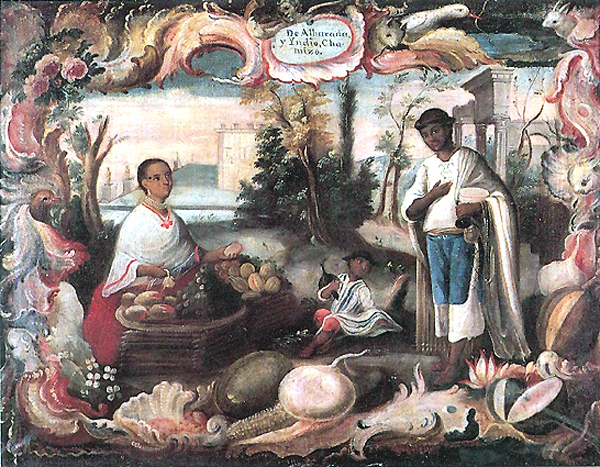Sistema or Sociedad de Castas
"Esquema de Mestizaje"
Ricardo E. Cicero
Catálogo de la Colección de Antropologia
del Museo Nacionale de México, 1895
Ilona Katzew, "New World Orders: Casta Painting and
Colonial Latin America",
Americas Society Art Gallery,
New York, 1996, Plate 22: Alabarada × Indian;
Chamizo, p. 86
To the reader: please do not take offense at the terminology
below. This terminology is clearly racist, and should be insulting
to many, many people. This terminology is here as it is a record
of how people were viewed.
Aside from terminology, members of each "casta" were more or less
distinguishable by their dress. Sumptuary laws specified dress that
would be illigal for members of specific castas to wear. Other ways
in which the castas were distinguished were as follows:
1
-
"The viceroy of Peru during the eighteenth century received
visitors in two rooms, one for whites, another for Indians
and mixed-bloods"
-
"... the whites went to mass in the cathedral, the pardos
to another church, and the Negroes to a third." Note: The
use of different churches by different "castas" may be seen
in the Brazilian film Xica da Silva.
-
"... the elementary school in Buenos aires was strictly
discriminatory. The teacher should teach only white and
Indian children to read and write, whereas mestizos and
mulattoes should be instructed only in Christian dogma,
and the groups were to be kept apart when the teacher
brought them to public functions."
-
cofradías (religious brotherhoods) and
consulados, and universities, guilds, etc. were
also limited to specific castas.
|
|
Parents
|
|
Offspring
|
|
Espanõl
|
×
|
india
|
mestizo
|
|
Espanõl
|
×
|
negra
|
mulato
|
|
Negro
|
×
|
india
|
zambo o zamba
|
|
Mestizo
|
×
|
espanõla
|
castizo
|
|
Mulato
|
×
|
espanõla
|
morisco 2
|
|
Negro
|
×
|
zamba
|
zambo prieto
|
|
Castizo
|
×
|
espanõla
|
espanõl
|
|
Morisco 2
|
×
|
mulata
|
salta atrás3
|
|
Zambo
|
×
|
mulata
|
calpan mulata
|
|
Salta atrás3
|
×
|
india
|
chino
|
|
Cal pan mulata
|
×
|
zambo
|
Tente en el aíre4
|
|
Chino
|
×
|
mulata
|
lobo
|
|
Tente en el aíre4
|
×
|
mulata
|
no te entiendo
|
|
Lobo
|
×
|
mulata
|
jibaro
|
|
No te entiendo
|
×
|
india
|
ahí te estás
|
|
Jibaro
|
×
|
india
|
albarrazado
|
|
Albarrazado
|
×
|
negra
|
cambuja
|
|
Cambujo
|
×
|
india
|
zambo o zamba
|
1
Magnus Mörner, "Race Mixture in the History of
Latin America", Little, Brown and Company, Boston, pp. 62-63.
.
2
"Morisco/Morisca" was used in the Iberian peninsula to
designate a Muslim, forced to convert to Catholicism (raza).
Hence, when used to designate complexion (skin color, or casta),
an ambiguity was created. "A royal decree in 1700 prohibited the use
of this term [morisco] to avoid confusion with the identical Spanish
word for 'converted Moor'." See Magnus Mörner,
"Race Mixture in the History of Latin America", Little,
Brown and Company, Boston, p. 58, footnote 21.
.
3
"Salta atrás" means a "jump backward", away from from
Spanish "blood". See Pedro Alonso O'Crouley (Sean Galvin,
trans.), "A Description of The Kingdom of New Spain, 1774",
John Howell, 1972, p. 19, footnote 2.
.
4
"Tente en el aíre" means "very much in the air",
or of dubious standing. See Pedro Alonso O'Crouley (Sean
Galvin, trans.), "A Description of The Kingdom of New Spain,
1774", John Howell, 1972, p. 19, footnote 3.
Back

